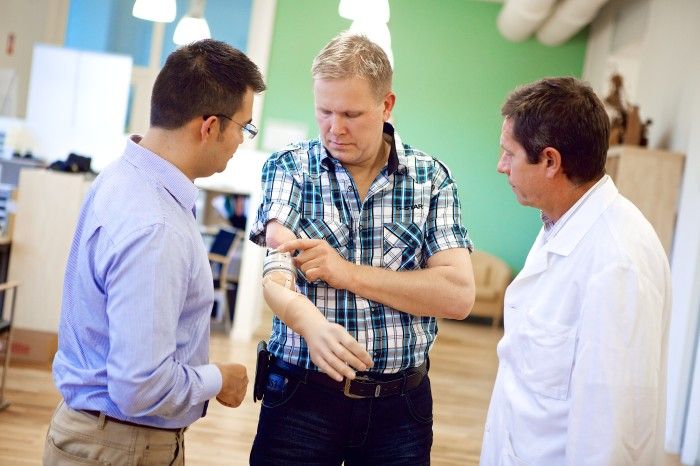Research shows mind controlled prosthetics are now reality
Courtesy Chalmers University of Technology
Max Ortiz Catalán, a research scientist at Chalmers, works with a mind-controlled prosthetic arm.
October 20, 2014
New research published Oct. 8 from Chalmers University of Technology located in Gothenburg, Sweden, and Case Western Reserve University, in Cleveland, Ohio, have revealed groundbreaking advances in prosthetics technology.
Case Western has discovered a connection between the brain and a prosthetic hand, bringing touch perception back to amputees by reactivating the parts of the brain that produce a sense of touch, according to Dustin Tyler, director of the research study and an associate professor of biomedical engineering at Case Western Reserve.
Tyler said touch perception is part of the sense of self, and if patients can feel touch again, it can change their views on prosthetics.
“Our subjects here, they’d often describe the prostheses as a tool that they were holding on to,” Tyler said. “But [they] would not visualize their hand actually doing the activity. They visualize their prostheses as a tool, not part of who they were. When we had sensation, though, that changed to where they described it as their hand grabbing an object.”
Human touch perception takes place in the brain, not in the hand itself. By placing electrodes on test subjects’ residual nerves, researchers were able to send signals to the subject’s brain, which create a response that simulates a natural limb’s ability to feel objects, according to Tyler.
Tyler said the human hand contains several different sensors in the fingertips that do not go away, even if the hand is lost.
“We place a device on the nerve—a couple sets of wires—and the goal is [to] figure out the right language, the right electrical pulsing to get those [nerves] to reactivate,” Tyler said. “When you start putting the same pulses on that nerve that you used to have with the hand, the brain doesn’t know that it isn’t from the hand. It interprets it as though it came from the original sensors that were there.”
Chalmers University also unveiled new prosthetics technology linked to the mind. A study co-authored by Max Ortiz Catalán, a research scientist at the university, created robotic prostheses controlled by an implanted neuromuscular interface. The robotic prostheses were previously controlled through electrodes placed on the skin, but that technology was often unreliable, according to the study.
Ortiz Catalán said controllability is the guiding goal for the mind-controlled prostheses.
“What we’re aiming to do is to restore the functionality of a missing limb,” Ortiz Catalán said. “You have tremendous control and dexterity with your hands. You can know where they are all the time—that’s part of the sensory feedback, and you can precisely grab delicate objects like eggs or glasses without breaking them. Conventional prosthetics don’t provide that kind of resolution. It’s very hard to tell the prosthetic hand to close a little bit.”
The new implant is a bidirectional interface, meaning signals can be transmitted between the brain and the prosthetic. Despite being in the early stages with only one patient currently using the new prosthetic, the researchers plan to start treating more patients with the technology later this year, according to Ortiz Catalán.
He said these advancements have taken many years of work to bring result.
“For 40 years or more, researchers have been trying to get devices implanted to get significant control [for] prosthetic devices,” Ortiz Catalán said. “It isn’t until now that we have integration and have this port into the body so we can have this communication [bidirectional interface] and patients can benefit from this technology.”
Jonathan Disbro, a resident prosthetist at Amputee Prosthetics in Washoe Valley, Nevada, and graduate of Northwestern University’s Feinberg School of Medicine, said the cost of such prosthetics is not practical.
“It’s hard enough for people to pay for their own prosthetics as it is,” Disbro said. “I can only imagine what mind-controlled prosthetics [are going to cost]. Who’s going to get that? Very few people. [Most] amputees are not going to be anywhere close to affording that. It’s interesting technology [but] it’s in its infancy. I’m not counting on [mind-controlled prosthetics] as a viable thing for most amputees.”
Disbro said what is even more important than new technology is doctors listening to their patients and making sure the prosthetics fit.
“The fit is the fundamental thing,” Disbro said. “Everyone talks about high technology and the latest and greatest new types of carbon fiber feet and this and that. Really what’s more important is a good fit for that person.”








